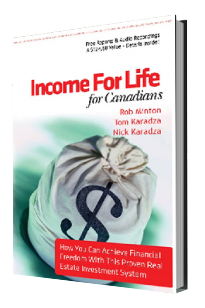Apartment Real Estate Investing
For all of you interested in apartment real estate investing, let's take a closer look at Cap Rates...
Apartment Real Estate Investing:
Cap Rates - What's all the fuss about?
When sizing up different investment opportunities one of the first numbers that is often looked at is the capitialization rate, or cap rate.
A quick search on Wikipedia brings up this definition:
“the ratio between the net operating income produced by an asset and its capital cost (the original price paid to buy the asset) or alternatively its current market value.”
To calculate the exact percentage you would take the annual net operating income and divide it by the cost (or value) or the asset.
For example, in apartment real estate investing, if you purchased a building that had a yearly net operating income of $100,000 for $1,000,000, your cap rate would be 10%.
In most major real estate markets, assets with a 10% cap rate are virtually unheard of. Today, most investors will be interested in 5 or 6 percent depending on what type of building or business it is they are purchasing.
Often multi-unit buildings in lower income areas, with a less than average typical tenant, will be advertised for sale with a higher than average cap rate for the area. In these cases, the owner is trying to make the property more attractive to an investor by lowering the price relative to the income the property generates.
This is a form of incentive for someone to take on a property that will require more management than is normal.
A lot of factors come into play when looking at cap rates.
That’s why it is important to understand exactly what is included in the calculations being used to come up with the number.
Although it shouldn’t, net operating income (NOI), which is essential to calculate cap rate, can vary depending on who is doing the calculation. Often the person selling the asset may end up with a slightly higher number than the buyer.
No surprise really, but this is why it is essential to double check everything when evaluating the possible purchase of an income producing asset (real estate, business, etc.).
The net operating income is calculated by taking the gross income generated and subtracting any operating expenses.
For the sake of apartment real estate investing, let’s use an apartment building as an example.
Gross income would include monthly rent, any laundry income, possible parking fees, and any other source of revenue for the building.
Operating expenses would include insurance, property taxes, heat, advertising, maintenance, utilities, landscaping, management, etc.
Operating expense would NOT include any mortgage payments that were required.
One common number that can vary greatly between buyer and seller, is the amount required for property management.
It’s not uncommon for the seller to leave that expense at $0 since they have been managing the building themselves.
But it doesn’t matter who does it, there should be a cost associated to it, and since management fees will most likely be 5% or more of the total rental income, it has a noticeable impact when calculating your cap rate and deciding on the investment opportunity.
These are the types of details that you need to be on the lookout for when looking at the income and expenses of buildings for apartment real estate investing.
Knowing what we know now, let’s take a look at a common single family rental that many have as part of their portfolio.
At a purchase price of $240,000, a common rental amount we see is $1,700. The monthly rent is usually the only source of income, so that would be $20,400 of income of the course of a year.
Let’s take 10% (a rough estimate) for some repairs, advertising, and time associated to mange the property which would leave us a NOI of $18,360.
If we take that number and divide it by our purchase price of $240,000, it gives us a 7.7% cap rate, which is extremely attractive in today’s low interest rate world.
Like we mentioned earlier, in a good area, many investors would often take a fraction of that and be happy with it.
There are other key factors when assessing investments.
In many cases we feel too much emphasis is put on cap rate.
Some Cool Free Stuff...
Step 1:
|
Grab a free digital copy of our real estate investing book, Income For Life For Canadians, right here. This book has been downloaded over 22,597 times and has helped hundreds of investors kick-start their investing with simple and straight forward strategies that you can implement right here in Canada. |
 |
|
You'll also receive our weekly [Your Life. Your Terms.] email newsletter with the latest investing updates and videos. |
Step 2:
|
Free Weekly Investing Videos & Articles: Get the latest updates and join the over 10,000 other Canadians enjoying the weekly [Your Life. Your Terms.] email newsletter. The email is sent out each Thursday. And as a little bonus we'll give a FREE digital copy of the book, Income For Life For Canadians, too! |
Your Life. Your Terms.
Step 3:
|
Free LIVE Investing Class: Do you live in the Greater Toronto or Golden Horseshoe Area? Come out to our next introductory "Investing in Nice Homes in Nice Areas" Real Estate Class. |
 |
|
It's 90-minutes and you'll learn a ton - promise!Thousands of investors have now joined us for this class and the feedback has always been amazing. |



